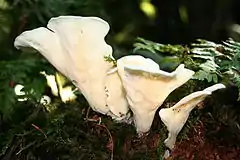Pleurocybella porrigens
Pleurocybella porrigens is a species of fungus in the family Marasmiaceae. The species is widespread in temperate forests of the Northern Hemisphere.[2] P. porrigens, known as the angel wing, is a white-rot wood-decay fungus on conifer wood, particularly hemlock (genus Tsuga).[3] The flesh is thin and fragile compared to the oyster mushrooms (Pleurotus ssp.).
| Pleurocybella porrigens | |
|---|---|
 | |
| Scientific classification | |
| Kingdom: | |
| Division: | |
| Class: | |
| Order: | |
| Family: | |
| Genus: | |
| Species: | P. porrigens |
| Binomial name | |
| Pleurocybella porrigens | |
| Pleurocybella Porrigens | |
|---|---|
float | |
| gills on hymenium | |
| cap is infundibuliform | |
| hymenium is decurrent | |
| stipe is bare | |
| spore print is white | |
| ecology is saprotrophic | |
| edibility: not recommended | |
Pleurocybella porrigens has historically been generally regarded as edible[3][4] but this has been brought into question by recent deaths apparently associated with P. porrigens consumption.
Synonyms for Pleurocybella porrigens include Pleurotus porrigens, Phyllotus porrigens, Dendrosarcus porrigens, Pleurotellus porrigens, and Nothopanus porrigens.
Description
The mushroom species is distinguished by its fruit bodies, which begin as a pure white and then form a tinge of yellow over time. The stipe is either very short or completely absent, and the flesh has a faint but pleasant smell.[5]
Toxicity
.jpg.webp)
Although P. porrigens is generally regarded as edible,[3][4] as of 2011, it has been implicated in two documented outbreaks involving fatal encephalopathy. Both incidents were in Japan, and most victims had pre-existing kidney disorders.[6][7][8]
The first incident occurred in September and October 2004[9] across nine prefectures in Japan, and involved the sickening of 59 people and the eventual death of 17.[6] Most of those who died had pre-existing liver problems, and the average age of those affected was 70.[6] Death occurred between 13 and 29 days after the onset of symptoms, and the onset of symptoms occurred at most three weeks after consumption of P. porrigens.[9]
The second incident occurred in 2009, when a 65-year-old man who had been on hemodialysis died from acute encephalopathy after eating P. porrigens.[6]
The mechanism of action for the toxicity of P. porrigens has not been definitively established,[6] but several possibilities have been suggested. It has been demonstrated that P. porrigens contains an unusual unstable amino acid which is toxic to the brain cells of rats in cell culture studies,[6][10] but it has not yet been possible to definitively determine that this was the cause of the fatal encephalopathies.[6] Other mechanisms have been suggested for P. porrigens's apparent toxicity, including the possibility that the fungus may contain toxic levels of cyanide salts.[11]
See also
References
- Singer R. (1947). "New genera of fungi. III". Mycologia. 39 (1): 77–89. doi:10.2307/3755289. JSTOR 3755289. PMID 20283546.
- Kirk PM, Cannon PF, Minter DW, Stalpers JA (2008). Dictionary of the Fungi (10th ed.). Wallingford, UK: CAB International. p. 548. ISBN 9780851998268.
- Trudell S, Ammirati J (2009). Mushrooms of the Pacific Northwest. Timber Press Field Guides. Portland, Oregon: Timber Press. p. 137. ISBN 978-0881929355.
- Arora D. (1986). Mushrooms Demystified (2nd ed.). Berkeley, California: Ten Speed Press. p. 135. ISBN 0898151694.
- Holmberg, Pelle. (2013). The pocket guide to wild mushrooms : helpful tips for mushrooming in the field. Marklund, Hans, 1937-, Hedström, Ellen. New York: Skyhorse. ISBN 9781620877319. OCLC 816030405.
- Michael W. Beug. "Pleurocybella porrigens toxin unmasked?". McIlvainea, Journal of American Amateur Mycology. Retrieved June 1, 2011.
- Saviuc P, Danel V (2006). "New Syndromes in Mushroom Poisoning". Toxicological Reviews. 25 (3): 199–209. doi:10.2165/00139709-200625030-00004. PMID 17192123. S2CID 24320633.
- Fumitake Gejyo; Noriyuki Homma; Noboru Higuchi; Ken Ataka; Tomoko Teramura; Bassam Alchi; Yukio Suzuki; Schinichi Nishi; Ichiei Narita (2005). "A novel type of encephalopathy associated with mushroom Sugihiratake ingestion in patients with chronic kidney diseases". Kidney International. 68 (1): 188–192. doi:10.1111/j.1523-1755.2005.00393.x. PMID 15954908.
- Kato T, Kawanami T, Shimizu H, Kurokawa K, Sato H, Nakajima K, Nomoto T, Seta T, Kamei T, Yoshino H, Sasagawa I, Ito M, Karasawa S, Kimura H, Suzuki Y, Degawa N, Tagawa A, Ataka K, Ando S, Omae T, Shikama Y (2004). "An outbreak of encephalopathy after eating autumn mushroom (Sugihiratake; Pleurocybella porrigens) in patients with renal failure: A clinical analysis of ten cases in Yamagata, Japan". No to Shinkei = Brain and Nerve. 56 (12): 999–1007. PMID 15729876.
- Wakimoto T, Asakawa T, Akahoshi S, Suzuki T, Nagai K, Kawagishi H, Kan T (2011). "Proof of the existence of an unstable amino acid: pleurocybellaziridine in Pleurocybella porrigens". Angewandte Chemie International Edition. 50 (5): 1168–1170. doi:10.1002/anie.201004646. PMID 21268219.
- Akiyama H, Toshihko T, Shinobu S, Yoshiaki A, Kazunari K, Yoshiko S-K, Tamio M (2006). "Determination of cyanide and thiocyanate in Sugihiratake mushroom using HPLC method with fluorometric detection" (PDF). Journal of Health Science. 52 (1): 73–77. doi:10.1248/jhs.52.73.
External links
| Wikimedia Commons has media related to Pleurocybella porrigens. |